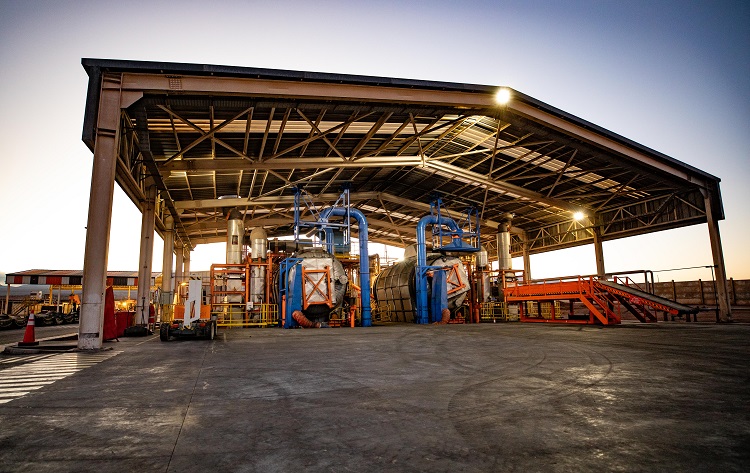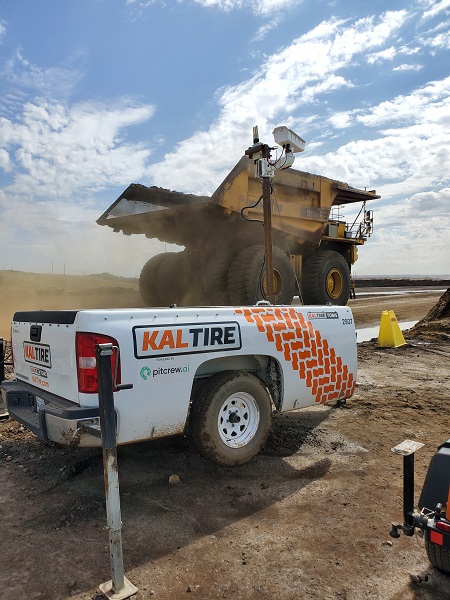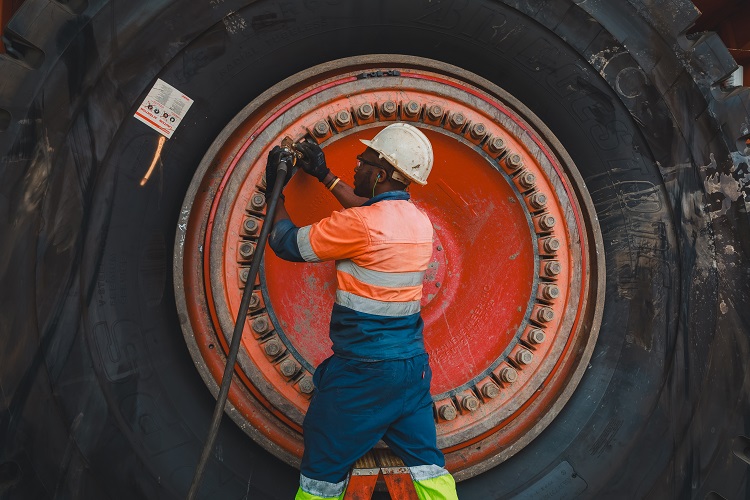Ahead of Investing in African Mining Indaba, vice president southern Africa of Kal Tire’s Mining Tire Group, John Martin, explores some of the latest additions to his company’s portfolio and why these could have a big future in Africa
In the exclusive interview with African Review, Martin began by touching on his company’s relationship with the conference in Cape Town and why is he keenly looking ahead for the 2024 edition. He stated, “I love going to Mining Indaba. It is a fantastic event to participate in and I think for us as an organisation it is a superb opportunity to learn about the developments and plans that the mining industry has for the African continent. It also remains an important requirement for us to continue the expansion of awareness of who Kal Tire is, articulate what we stand for and how our value proposition can make our customers more competitive. We started some years ago at the conference with the intent of raising awareness of our brand on the continent and this has worked quite well for us. By participating in Mining Indaba again, we will continue to do that, to highlight the breadth and width of our offering, and develop our network.”
The company has indeed become a more established name within the African mining community, and serves the continent through two channels which are, according to Martin, both performing strongly. In the West of the continent, the company has recently expanded into more countries such as Mali and the Côte d'Ivoire while, in the South, it remains operational in South Africa, Mozambique, Botswana and Zambia but uses these bases to springboard into other countries such as DRC.
“We remain very vigilant and interested in other countries that surround the areas we are active in and have infrastructure to support, particularly in South Africa,” added Martin. “Countries like Namibia and Lesotho remain extremely attractive for us as possible expansion opportunities which we are keeping tabs on to grow our footprint.”
OTR thermal conversion
So, what is Kal Tire offering to the market that will support this envisioned growth trajectory?
Well, while there is a wide portfolio in Kal Tire’s offering for customers to explore that can enhance their operations, Martin selected a sample of innovations the company has added to its repertoire that could have a big impact on sites across the continent.
The first was introduced in light of the fact that the mining industry is one of the biggest global users of off-the-road tyres, a product with few options for refuse or reuse and that is a growing concern for companies operating in an ever-intensive ESG environment. In response, Kal Tire committed its resources to developing a way to recycle ultra-class tyres to help promote a circular economy and successfully opened its debut thermal conversion OTR tyre recycling facility in northern Chile. The facility is capable of processing five 63” tyres every day to create 6,500 litres of alternative fuel, 4,000 kg of steel and 8,000 kg of carbon black, in addition to synthetic gas to fuel the plant itself.

“The appeal really comes in both the quality of the finished products and the entire offering,” explained Martin. “We have traceability of every single tyre that comes into the facility and we can prove to the customer that their tyre has been processed in a facility that fully supports the circular economy. 100% of what goes in comes out the end and back into the economy in different forms and can be fully utilised – many other recycling solutions do not offer this.
“This has been proven in that, for the Chilean facility, Kal Tire was awarded the International Sustainability and Carbon Certification (ISCC) PLUS certification, providing our customers with an immense amount of confidence while showing them the products generated are of the highest quality and best use within the circular economy.”
With the facility continuing to make progress, Martin is already eyeing up opportunities for bringing the blueprints to Africa. He said, “You will see at Mining Indaba how committed the industry is to measuring and reporting on their ESG performance against targets they have set or that has been given to the industry. They are keen to explore all sorts of avenues to achieve all the components that are associated with ESG and reducing one’s carbon footprint is ever-present on the agenda. Recycling tyres is a very effective way of reducing Scope 3 emissions.
“This is also a flexible solution designed with the understanding that it could go into any mining geography in the world and, as part of this, is therefore scalable. You can have a single chamber, two, three or more, depending on the volume of feedstock available from a customer, or group of customers in one geographic location. Is it of interest to Africa then? Absolutely!”
Kal Tire is already in negotiations with one customer in South Africa around implementing the thermal conversion solution and, as mining companies in Africa continue to raise their ESG targets (and countries strengthen their environmental legislation), it may not be long before Africa sees a sister facility established on its shores.
Ensuring continuous operations
Another vital part of Kal Tire’s focus is centred on tyre maintenance, a key aspect of minimising mobile mining machinery downtime. Martin remarked, “This has such a big effect on the performance of the fleet, the cost of operations and, of course, the safety of personnel. Generally, on the continent there is a good understanding around this, but there are a few caveats.
“In most mines, maintenance usually comprises of an agreed tyre and rim strategy often revolving around established rotation targets or plans. On most sites, machines are brought in at a certain point in time, the tyres are rotated, perhaps the studs are replaced, and this is generally done on a planned cycle that coincides with regular maintenance intervals of the machine itself.
“One of the inconsistencies that we deal with is the identification of the damages that one sees on tyres. Static inspections make it difficult for inspectors to examine the whole tread area, and therefore difficult from a single visual inspection to determine the severity of the damage, which may result in a misdiagnosis and prioritization of the work required.”
Fortunately, the company is constantly innovating to combat such issues. Four years ago, this led Kal Tire to introduce its proprietary Tire & Operations Management System (TOMS) which utilises an Enterprise Asset Management system to track and report on tyre performance. Operational in more than 130 mine sites worldwide, TOMS automates priority-based work to help plan preventative tyre maintenance to improve the mean time between services, and features near real-time standardised service delivery reporting while integrating seamlessly with third-party systems.
In a bid to enhance this offering even further, in 2021 Kal Tire integrated TOMS with the thermal imaging software from Pitcrew.ai. Although tyre pressure monitoring systems (TPMS) are a well-established method of getting a picture of what is happening inside a tyre, with Pitcrew.ai’s addition, tyres passing in front of the stations are also subject to thermal imaging video footage which is scanned by AI software for anomalies such as hot spots, belt edge and tread separations.
this offering even further, in 2021 Kal Tire integrated TOMS with the thermal imaging software from Pitcrew.ai. Although tyre pressure monitoring systems (TPMS) are a well-established method of getting a picture of what is happening inside a tyre, with Pitcrew.ai’s addition, tyres passing in front of the stations are also subject to thermal imaging video footage which is scanned by AI software for anomalies such as hot spots, belt edge and tread separations.
These autonomous inspection stations are capable of detecting tyre issues as the vehicles pass by. “These stations examine the tyre and tread over three to four rotations as it travels past, allowing for a much better picture of the potential damage that exists on every single wheel position,” Martin explained. “This inspection is thus done autonomously, in real time and avoids the machine having to stop (unless a problem is spotted of course).
“When combined with TPMS, you have a very powerful combination,” continued Martin. “The TPMS system measures the performance and shows what is happening inside the tyre while with the addition of Pitcrew.ai you have a view of what is happening on the outside as well. With the AI capabilities it will automatically assess the priority and advise as such. If it is a potentially catastrophic injury, the machine will be flagged to be stopped immediately, if not as serious, the system will attach a priority status through the issuing of a work order.
“This new system is attracting a lot of interest from the mining community and we have presented it to pretty much every customer where Kal Tire is on site, providing maintenance. We currently have about four units around the world that are installed and currently operating, and we have eight systems on order for the next 12 months that need to be commissioned. In South Africa we have received confirmation for a major customer to test the system and I would think we will have a system imported and operational by the second quarter of 2024.”
Meaning more to the industry
The development of such advancements are all part of the company’s efforts to be recognised as “not just the average run-of-the-mill service provider,” in the words of Martin. “We want to be more to the mining industry and the economy. With our expanding and innovating portfolio we show customers that we can offer a very wide range of services from managing tyres and extending their life, all the way to recycling.”
Indeed, Kal Tire’s sustainability has been amplified in this context by having just received a Level 1 B-BBEE certification, an achievement Martin was immensely proud of.
“Being a Level 1 contributor in the South African business environment is certainly one of the key and critical pillars on which we rely on for our long-term sustainability. When you combine this with our 51% black ownership of our operating company in South Africa, this provides our customers with confidence that if they work with us it will help them to achieve their own related targets, and they will be more competitive.
“When we procure our products, it is our preference to buy from other Level 1 companies that are like minded in their approach to transformation, who too are at least 51% black-owned. We make use of only a handful of suppliers who are absolutely key and strategically important to our sustainability. This is how we would like our customers to view us – we can now provide that same benefit to our customers, allowing them to grow and develop on their own BBEE journey.
“I would add that, in the South African economy, things are never static. So achieving Level 1 and 51% black-owned, is only a milestone, not the destination. The next step for us would be to identify local community partners and local businesses we would like to share business with to help grow and develop in line with our own journey.”






















